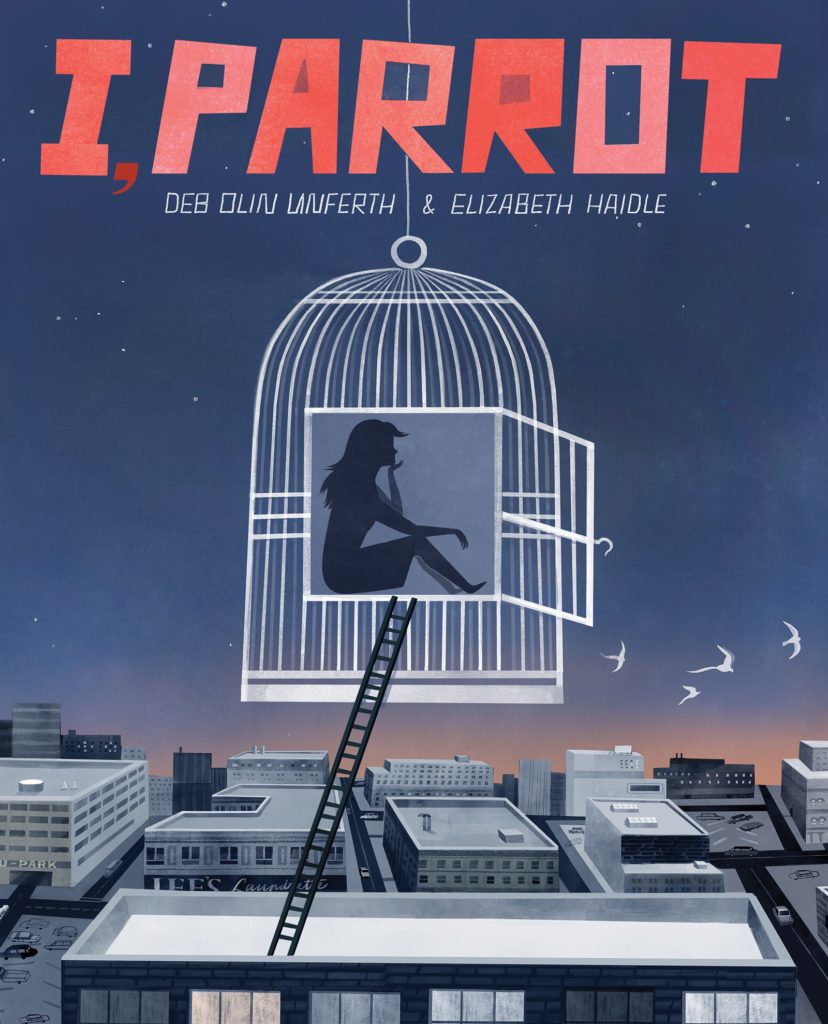I, Parrot: A Graphic Novel
Reviewed by John Biscello
“A black-sharded lady keeps me in a parrot cage.”
Sylvia Plath
The power of the black-sharded lady, a cunning saboteur of a shadow-self, resides less as a jailor and more as an illusionist. She creates a phantom cage out of thin air, and conditions one to behave and function as a captive, barred from moving beyond limitations that calcify into tainted gospel. In the new graphic novel I, Parrot, written by Deb Olin Unferth and illustrated by Elizabeth Haidle, cages, both real and metaphysical, play into what is a modern-day fable on survival, fierce love, and the necessity of wing-spreading. Or, as Emily Dickinson so eloquently stated: “Hope” is the thing with feathers.
Daphne’s travails with the parrots turns into an operatic fiasco, involving her boyfriend, her son, and a trio of housepainters, the three Lee Anthony’s, who could be surrealistic stand-ins for the Marx Brothers. Part of I, Parrot’s charm derives from its connection to old-school cinematic farce. You could easily imagine Buster Keaton navigating through the pitfalls of this parrot-centric episode, or Laurel and Hardy negotiating fits of cartoonish despair with fool’s grace. And, with permanent blushes branded on the cheeks of the characters, Haidle’s whimsical, Sunday-comic-strip-style illustrations perfectly underscore the narrative’s timbre. Rendered completely in gray-scale, the world through which Daphne moves strikes one as an in-between place, a Bardo waiting room preceding rebirth. There is also a fluid and dynamic sequencing to Haidle’s artwork, a kinetic spatial interplay that plays out like a sort of visual jazz.
One of the novel’s most compelling and haunting sub-plots revolves around the Passenger Pigeons. Having been declared extinct in 1914—“You might even say their extinction signaled the birth of a new era … modern art, modern weaponry, the Industrial Revolution, electric lights, the free world.”—there have been recent sightings of what may be the second coming of Passenger Pigeons. Throughout the book they appear like totemic wraiths, or Sumi-e-esque specters arranging themselves into divine patterns of symmetry. The guide-book, I-Parrot, glibly warns against the risks of intimate flocking, and cites the Passenger Pigeon as a prime example: “Consider the Passenger Pigeon. They once flew in flocks 50 large so they blacked out the sky for hours at a time, whole horizons in darkness. Look what happened to them. Our advice? Scatter.”
In a broad, orchestral sense, I, Parrot shines a light on the amorphic gray areas that give rise to what we choose to value, honor, cherish, and protect. And how that sculpts the shape and character of the future. On a personal and primal level, I, Parrot’s heartbeat is metered to a timeless and singular force: a mother’s inviolable love for her son.
♠
I/Parrot, by is out on Black Balloon Publishing (November 1, 2017)
~
Originally from Brooklyn, writer, poet, playwright and performer, John Biscello has called Taos NM home since 2001. He is the author of two novels, Broken Land, a Brooklyn Tale and Raking the Dust, as well as a collection of stories. To see more of his work, visit johnbiscello.com
